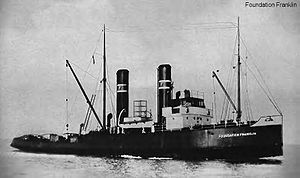Foundation Franklin
 The Foundation Franklin before World War II. Two "F"s are clearly visible on the smokestacks. | |
| Career (Britain, Germany, Canada) | |
|---|---|
| Builder: | John Lewis and Sons Shipbuilding of Dundee, Scotland |
| Laid down: | 1918 |
| Launched: | 1919 |
| Commissioned: | 1919 |
| Decommissioned: | 1948 |
| Renamed: | HMS Frisky, SS Gustavo Ipland |
| Fate: | Scrapped in 1950 |
| General characteristics | |
| Class and type: | Dainty |
| Displacement: | 1050 tons |
| Length: | 156 ft (48 m) [between perpendiculars] |
| Beam: | 32 ft (9.8 m) |
| Draft: | 14 ft (4.3 m) |
| Installed power: |
Steam, Coal Fired. Converted to oil in 1946[citation needed] |
| Propulsion: | Triple expansion steam engine, 1200 hp |
| Speed: | 12-15 knots |
| Complement: | N/A |
The SS Foundation Franklin was a sea-going salvage tug built for the Royal Navy in 1918 but most famous for many daring salvage operations and rescues while operated by Foundation Maritime between 1930-1949.
History
Foundation Franklin was built as HMS Frisky, a Racia type tug, by John Lewis and Sons Shipbuilding at Dundee, Scotland, in 1918. She was designed to move capital warships, and operate in rough weather. The ship was commissioned in the spring of 1919, but the ending of World War I ended the need for the HMS Frisky. She was used to tow warships to Scapa Flow until being laid up. In 1924, the ship was sold and performed towing work on the Rhine River and in the Baltic Sea. The Frisky was later purchased by a German project intending to tow barges across the Atlantic Ocean to Argentina and renamed SS Gustavo Ipland, but the project was destined to fall through. The former HMS Frisky then was laid up until 1930.[1]
The ship was purchased in January, 1930 at Hamburg, Germany by Foundation Maritime representative Captain James Sutherland at Hamburg, Germany. Brought to Southampton for further refit and inspection, she was registered under the Red Ensign and given the name Foundation Franklin. Brought to Foundation Maritime headquarters in Montreal, Canada in 1931, the tug was further refitted by Halifax Shipyards for Atlantic salvage service.
After a few salvage jobs based along the Saint Lawrence River, Foundation Franklin established a homeport at Halifax, Nova Scotia for the rest of her career.[2] One of the most successful and hard-working vessels of her type, Foundation Franklin carried out many remarkable rescue and salvage exploits.[3] She continued to operate in the salvage role until 1948, when, during the tow of the vessel Arosa a hurricane damaged the ship beyond economical repair. Her many rescues and salvage triumphs were celebrated in Farley Mowat's book The Grey Seas Under.
Her bell, bearing her original Royal Navy name "Frisky", was saved from the scrapyard and used at the Foundation Wharf to summon crews to successor rescue tugs when vessels were in distress. The bell has continued to reside at offices beside the company's wharf through successive ownership changes. Today it is owned by Svitzer Canada Limited which continues to operate tugs from Franklin's old wharf. A plaque beside the wharf on the Halifax Waterfront Boardwalk commemorates her many rescues. The Maritime Museum of the Atlantic preserved Franklin's bridge and engine room clocks as well as several models and the tug's heavy salvage tackle. Foundation Franklin was the centrepiece of a special tug exhibit which opened at the Museum in 2009 displaying many pieces of her original equipment and her original bell on loan from Svitzer Canada.[4]
Masters of Foundation Franklin
- 1930 - Captain James Sutherland.
- 1930-1932 -unknown
- 1932 - Captain Lewis.
- 1932-1934 - Captain Reginald Featherstone (and others). Featherstone was Salvage Master
- 1934-1940 - Captain Irwin Power. (Power was later Master of Foundation Aranmore)
- 1940(temp.)- Captain Benjamin Pope
- 1940 - Captain John Pynn.
- 1940-1941 - Captain Cecil Ormiston.
- 1941-1947 - Captain Harry M. Brushett.
- 1947-1948 - Captain John Lahey.[5]
References
- ↑ Mowat, Farley (May, 1964). The Grey Seas Under. pp. 14.
- ↑ Mowat, Farley (1958). The Grey Seas Under. pp. 16.
- ↑ *"Salvage on the Grey Seas", Haze Grey and Underway website, a list of Foundation's major salvage jobs
- ↑ *Press Release Maritime Museum of the Atlantic, March 13, 2009
- ↑ Mowat, Farley (May, 1964). The Grey Seas Under. pp. 36, 57, 83, 100, 133, 142, 150, 246.
External links
